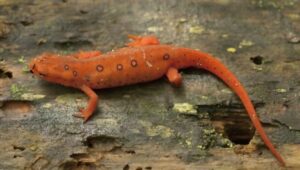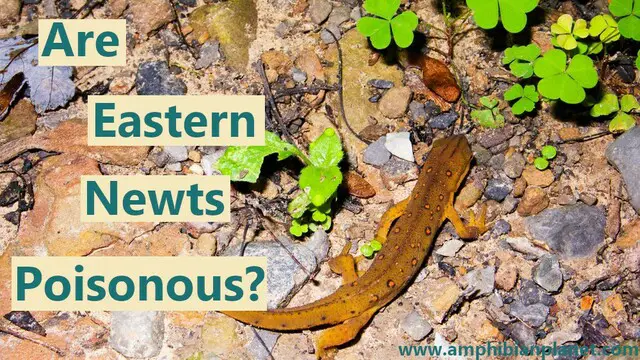Eastern newts (sometimes called eastern red-spotted newts) are found across much of the eastern united states and up into Canada. These newts are easy to identify by their olive-green coloration and the black-bordered red spots along their back. But are eastern newts poisonous?
Eastern red-spotted newts produce a highly poisonous toxin known as tetrodotoxin as a defense against predators. Juvenile newts known as ‘red-efts’ are more than ten times more poisonous than adults and have a brilliant orange-red coloration that warns predators of their toxicity.
Tetrodotoxin has no known antidote and can cause death by suffocation in as little as six hours after ingestion.
Despite the presence of this skin toxin, eastern newts are quite safe and unlikely to cause you problems as long as you take a few simple precautions.
To be safe, very carefully wash your hands after handling eastern (or any) newts. Before washing your hands, do not touch your face, especially not your eyes or mouth.
Eastern Newts Have 3 Life Stages With Different Levels of Toxicity
Female eastern newts lay their eggs in vernal pools, ponds, and other fishless water bodies. After a few months, these eggs hatch into tiny larvae that have smooth olive-green skin, external feathery gills, and live much like tadpoles.
At this stage, the larvae are not very toxic and are preyed on by many predators. However, research has shown that they are capable of increasing the production of toxins while around predators.
Red Efts Are Extremely Poisonous
After about five months, the aquatic larvae undergo a process known as metamorphosis in which they shed their gills and develop limbs for a life on land.

This is their teenager or ‘red-eft‘ stage of life. In this juvenile stage, eastern newts are very highly poisonous and sport a brilliant orange-red color that warns predators of their potent toxin.
Adult Eastern Newts Are Mildly Poisonous
After about two to three years, the efts mature into adults and return to the water to live a mostly aquatic life.
As adults, the vivid orange-red coloration of their juvenile stage changes to an olive green coloration with red spots on their back (hence the name “red-spotted newt”).

Adult eastern newts are only about one-tenth as toxic as they were in their red eft stage. However, their toxin is still very potent in sufficient quantities.
Coloration Tells Predators That Eastern Newts Have a Toxin
Many poisonous animals advertise the fact that they are toxic by having bright or contrasting colors. This is called aposematism or warning coloration.
It makes predators aware that the brightly colored animal is poisonous or distasteful and would make a horrible meal.
In the case of eastern newts, the bright orange-red coloration of their juvenile phase warns predators of their highly toxic skin secretion.
Even though adults are only one-tenth as toxic as efts, the red dots still serve as a reminder to predators that they are not to be messed with.
An animal that eats a brightly colored eastern newt will get very sick and remember the experience. The next time the animal sees another similarly colored newt, it will associate the coloration with danger and learn to avoid that particular species.
“Poisonous” Is Not “Venomous”
You have probably heard the words venomous and poisonous used almost interchangeably. However, they mean very different things. Sure, they both refer to toxins that can be harmful to us, but the difference lies in how those toxins are delivered.
Generally,
- Venomous animals inject toxins into their victims, usually through fangs, stings, or barbs.
- Poisonous animals are toxic when they are eaten or their toxins are somehow ingested.
The easiest way to think of it: If an animal is toxic because of a bite or sting, it is venomous (think rattlesnakes). If an animal is toxic when you touch, eat or lick it, it is poisonous (think poison dart frogs).

Eastern newts do not have the ability to inject their toxin, they are only poisonous when their toxins are ingested. This means they are poisonous but not venomous.
Are Eastern Newts Dangerous to Humans?
Eastern red-spotted newts are typically harmless to humans. While they do secrete a potent toxin, it is unlikely to be of serious harm to humans unless the entire newt is swallowed.
Since most people won’t try to eat or lick a newt, the most likely way you would be harmed would be by handling an eastern newt with your bare hands, then rubbing your eyes or touching your mouth without first washing your hands.
Doing this would enable the toxin to come in contact with your mucous membranes and most likely lead to serious irritation.
You could also be harmed by handling an eastern newt with cuts or scratches on your hands, enabling the toxin to be absorbed into your body.
Toxins absorbed this way would most likely lead to an intense burning sensation and a feeling of numbness at the point of contact.
Newts Can Carry Salmonella
Nearly all amphibians can carry bacteria that can make humans sick. One important bacteria is salmonella. Newts carry salmonella bacteria in their intestinal tract and shed these bacteria in their waste.

Salmonella bacteria usually do not cause any illness in newts but can infect people who come in contact with them. You can be exposed to salmonella through contact with a newt’s feces or anything that has come in contact with them.
Exposure to salmonella bacteria can cause an infection called salmonellosis in humans. Most infections are non-life-threatening but the bacteria can be absorbed into the bloodstream from the intestines and infect other organs leading to severe illness.
Fortunately, you will not get a salmonella infection by simply touching a newt, the bacteria can only cause illness when they make their way into your body.
As a safety precaution, always wash your hands with anti-bacterial soap after handling newts, their cages, equipment, or anything in their enclosure.
Are Eastern Newts Dangerous to Dogs or Cats?
Since eastern newts secrete a toxin, a dog, cat, or any other pet that licks or eats one of these newts is potentially at risk of poisoning.
While adult eastern newts are only mildly toxic, juvenile (red-eft) eastern newts have a very potent toxin that can be lethal to a dog in sufficient quantities (such as if the newt is eaten).
For this reason, it is important to keep your pets away from any newts be it in the wild, or any pet newts you may have at home. Keep pet newts in a secure enclosure so they do not come in contact with any of your other pets.
If you notice your pet attacking a newt, take it away from the newt and contact your vet right away for further instructions.
Safety Precautions to Take When Handling Eastern Newts
Generally, it is not a good idea to handle newts. This is because they have a very delicate absorbent skin that allows liquids and gases to pass through it.
This means that chemicals and other harmful things on your hands can pass right through their skin and end up inside their body.
For this reason, if you ever need to handle a newt (or any other amphibian) take the following precautions.
Before Handling
Make sure your hands are clean and washed off very thoroughly. Not just clean from dirt, but washed off so thoroughly that no residue of soap, lotions, or any other substances that could harm the newt remain.
Even better, you could wear protective gloves( such as vinyl or latex gloves). Wearing gloves will not only protect you from potentially coming in contact with the newts’ toxins but will also protect the newt from coming in contact with harmful substances that may be on your hands.
While Handling
- Keep the newt away from your eyes nose and mouth and, be very careful not to touch your eyes, nose, or mouth.
- As you handle the newt, do it very gently and do not cause it any stress. Newts only secrete their toxin to defend themselves when they feel threatened. Therefore, stressing a newt will make it secret its toxins all over your hands.
What to Do After Handling
After handling, wash your hands with anti-bacterial soap so you do not ingest any toxin or bacteria you may have picked up from the newt.
Even if you were wearing gloves, I recommend you go the extra mile and wash your hands to protect yourself. Before washing your hands, do not rub your eyes, touch your face or put anything in your mouth.
Frequently Asked Questions:
Question: Can an Eastern Newt Kill You?
Answer: Eastern newts, especially in their red eft phase, have a toxin that is potent enough to be lethal to a human. However, simply touching an eastern newt won’t be lethal. You would have to actually eat the newt to ingest enough toxins to cause you serious harm.
Question: Do Eastern Newts Bite?
Answer: Almost any animal with a mouth can use it to defend itself when necessary. Eastern newts do bite, however, they are very docile creatures and will rarely bite a human.
The most likely time an eastern newt will bite a human is when it is being handled in a way that causes it stress. A bite from one of these newts is not much to be worried about because it is venomous or anything of that nature
Conclusion
Eastern newts are amazing little creatures that are popular pets among many amphibian enthusiasts. While they possess a toxin, the only danger comes when you touch or handle them so it is best to leave them alone.
This will not only protect you from the newts’ toxic secretions but will also protect the newt from any harmful substances on your hands. It’s a win-win!


